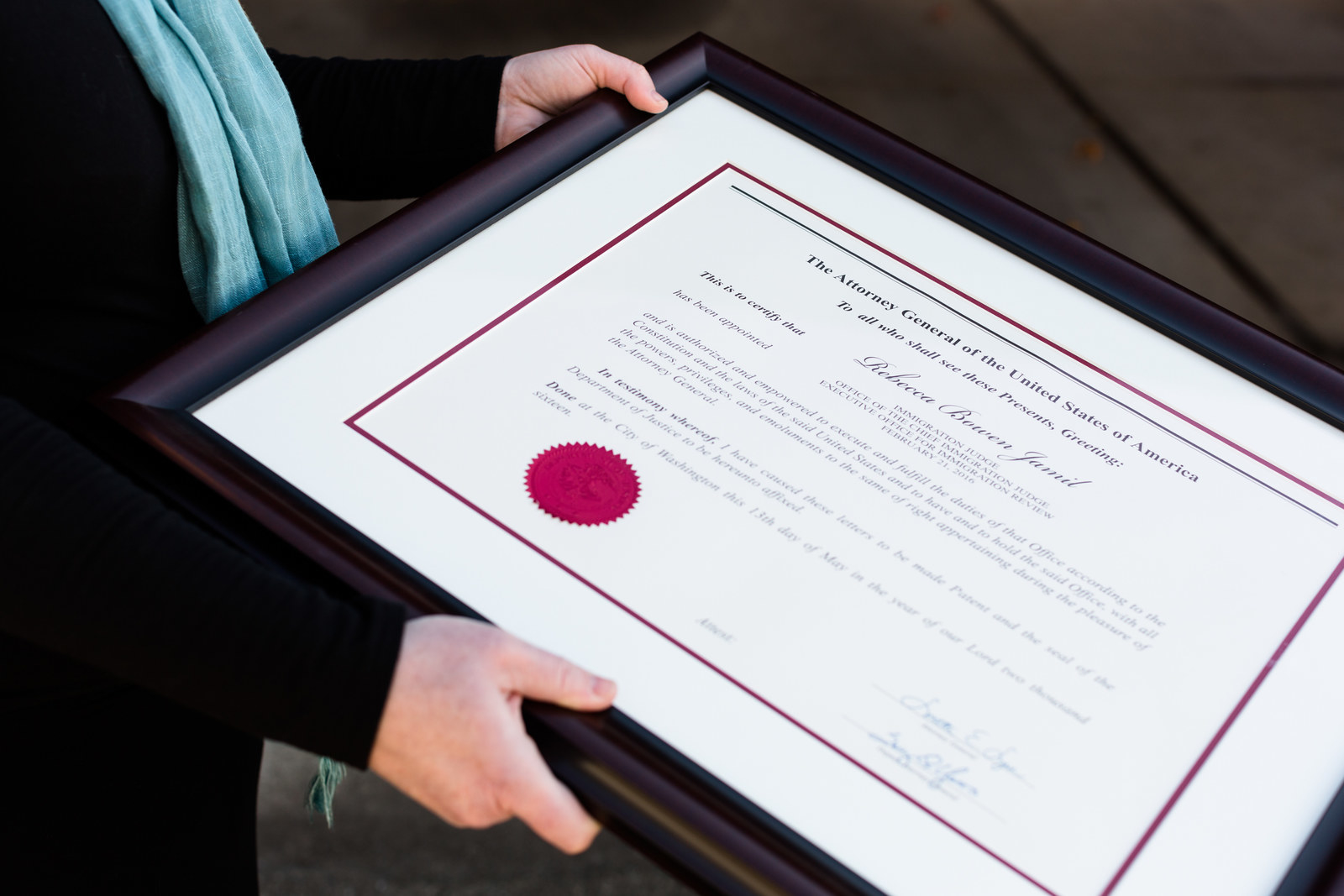
American Author & Attorney
PHOTO: By David Zaugh on Elizabeth L. Silver Wevsite
https://lareviewofbooks.org/article/what-does-credible-fear-really-mean/
What Does “Credible Fear” Really Mean?
May 24, 2021 • By Elizabeth L. Silver
A FEW MONTHS BEFORE COVID-19 descended, I spent a week in Dilley, Texas, as a volunteer attorney at the South Texas Family Residential Center, which is essentially a holding center, specifically for women and their children. It’s the last stop before expedited removal and the place where many women and children are sent once they’ve claimed fear of persecution for the purpose of applying for asylum, or for those who have also been apprehended internally.
I was working with asylum seekers at the Mexican border port of entry, where people were held without answers for weeks, even months, while they awaited the next step in their asylum claims: the credible fear interview. If asylum seekers, fleeing persecution in their home countries, declare their fear of returning, they are detained as they await this interview, which will determine whether they can proceed to the next step: appearing before an immigration judge to request asylum. The conversation leads to a proverbial thumbs up or down, a trip to a courtroom or the border they just fled. If an asylum officer determines that their story has objective elements of credible fear, they may proceed to the next legal step. Officers essentially check required elements off a list, including what the specific act of persecution is, if the asylum seeker knows the reason why she’s been persecuted, how many times it happened, if she has sought help to remediate it, and more. In other words, asylum seekers’ lives depend on the hour or so answering questions spent either in a small room or, more likely, over the phone with a government official and interpreter.
Right now, our country again faces a critical point in defining our identity: are we in fact a country founded on freedom and designed to welcome those in need? The Biden administration states that it aims to help asylum seekers, but in order to do so we need to reevaluate how we approach asylum at all levels. That begins with reassessing how we determine credible fear.
During my brief time working in Dilley, I helped women prepare for their credible fear interviews. Many asylum seekers might not understand the process, nor necessarily know which details of their stories determine what the United States has deemed credible fear. Asylum is not a guaranteed right, and attorneys are not permitted to help during the interview; thus, preparation is key.
I spoke with a woman who fled five countries to escape her abusive boyfriend. The man followed her from country to country, raping her and threatening her life in each country. No matter where she fled in South and Central America, he followed her. Her five-year-old son, a product of one of these rapes, held her hand during our conversation in the detention center. I spoke with another woman who was threatened by a well-known drug cartel. Through her tears, she could barely communicate to me that they had already killed her brother, taken her money, patrolled the school where she taught, and routinely policed her town, spitting bullets as easily as words. As I interviewed the women, they cradled their young children, who were also visibly traumatized by what they had experienced in their home countries, by their journeys to the United States, and finally by the process to gain safety on this side of the border.
The credible fear interview places the burden of establishing fear on the applicant and is supposed to be non-adversarial, but given the nature of everything that precedes the interview — the lack of representation during the process, the jail-like location in which it takes place, the asylum officer’s constant questions — it feels adversarial. And this is just the first step. If the officer determines that she does have credible fear, the next step is to present her case to an immigration judge in a proper hearing.
. . . .
******************
Sadly, and completely unnecessarily and inappropriately, there is nobody in a leadership position at DOJ right now with Elizabeth Silver’s practical insights and understanding of our broken asylum system and how it can be fixed! I’ll bet that neither Garland nor anyone on his senior staff has spent a week at Dilley or any comparable site in the “New American Gulag” trying to represent vulnerable asylum seekers in Garland’s “wholly owned star chamber courts.”
Has Garland even taken the time to observe what’s happening in Dilley, Pearsall, Texas (“home of the Big Peanut”); Jena, Louisiana; Lumpkin, Georgia (“where asylum cases go to die”), or any of the other comparable “courts” (that don’t function like “courts” at all)? Has he ever spoken to asylum applicants and their pro bono lawyers trying to negotiate his fatally flawed and intentionally “user unfriendly” system? Has he gone out and hired progressive “practical scholars” to fill in his “blind spots?”

That says loads about AG Merrick Garland — none of it good! “Ignorance,” “intransigence,” and “good enough for government work” are not acceptable approaches for the Biden Administration! Yet that’s exactly what Garland has “delivered” on immigration, human rights, racial justice, and gender equity during his first three months at “Justice.”
Of course it’s adversarial! Totally, these days!
The White Nationalist racists in the Trump regime like Miller, “Gonzo” Sessions, “Wolfman,” “Cooch Cooch,” and “Billy the Bigot” hated asylum seekers, people of color, and women and “biased out” the system and selection processes accordingly. Heck, in clear violation of the statute, Trump even replaced USCIS Asylum Officers with totally unqualified Border Patrol Agents to insure denial of even the most compelling claims!
Sessions bogusly bellyached about too many individuals passing “credible fear.” To the contrary, this was totally appropriate, given the “super generous” standards that are supposed to be applied at the “access to the system gateway.” The real systemic problem was in the historically poor performance of the Immigration Courts on asylum grants that got immeasurably worse under Sessions and Barr. (And has remained beyond horrible under Garland’s non-existent “leadership!”)
As almost all legitimate human rights experts would confirm, the “high rejection rate” later in Immigration Court results from far, far, far too many unqualified, non-expert, improperly selected, poorly trained, Immigration “Judges” — at both the trial and appellate levels — operating in a “culture of institutionalized racism, misogyny, and default denial” rather than the generous atmosphere and culture required by the Supremes in INS v. Cardoza-Fonseca but never truly implemented at EOIR.
“Herculean” although the task might appear, there are thousands of well-qualified immigration and human rights experts, most of them in the private sector right now, who could solve this problem and establish due process, fundamental fairness, real asylum expertise, and the rule of law in short order. But, Garland and Mayorkas have failed to remove the deadwood and the Trump/Miller holdovers and have not brought in the expert problem solvers to get this currently deadly, defective, illegal, and blatantly unconstitutional system under control. Additionally, qualified, expert Immigration Judges, REAL independent, courageous Federal Judges, not “go along to get along “bureaucratic retreads,” could also train and effectively supervise the Asylum Officer Corps, rather than woodenly and often ignorantly “rubber stamping” defective denials of “credible fear.”
Incredibly, Garland aggravated this festering problem “right off the bat” by improperly hiring 17 new, non-expert, not judicial quality Immigration Judges from flawed recruitments, skewed lists, and bogus recommendations developed by “Billy the Bigot” Barr! What an amazing lack of awareness and “open dissing” of humane progressive values and commitment to quality in Government!
Does this group represent the type of diverse, progressive candidates that President Biden would nominate for Article III Judgeships? OF COURSE NOT! Then, what possible excuse is there for “gifting” them some of the most powerful and important Federal Judgeships — those with probably more “life or death” authority and discretion over individuals than even the Supremes? No excuse whatsoever!
Our asylum system is totally “fixable.” Immediate improvements can be made and noticeable systemic changes could and should be in place before the end of this year! But, not the way that Garland and Mayorkas are going about it! The deadwood needs to go NOW, and be replaced with expert, progressive leadership, judges, and adjudicators!

🇺🇸Due Process Forever!
PWS
05-25-21







